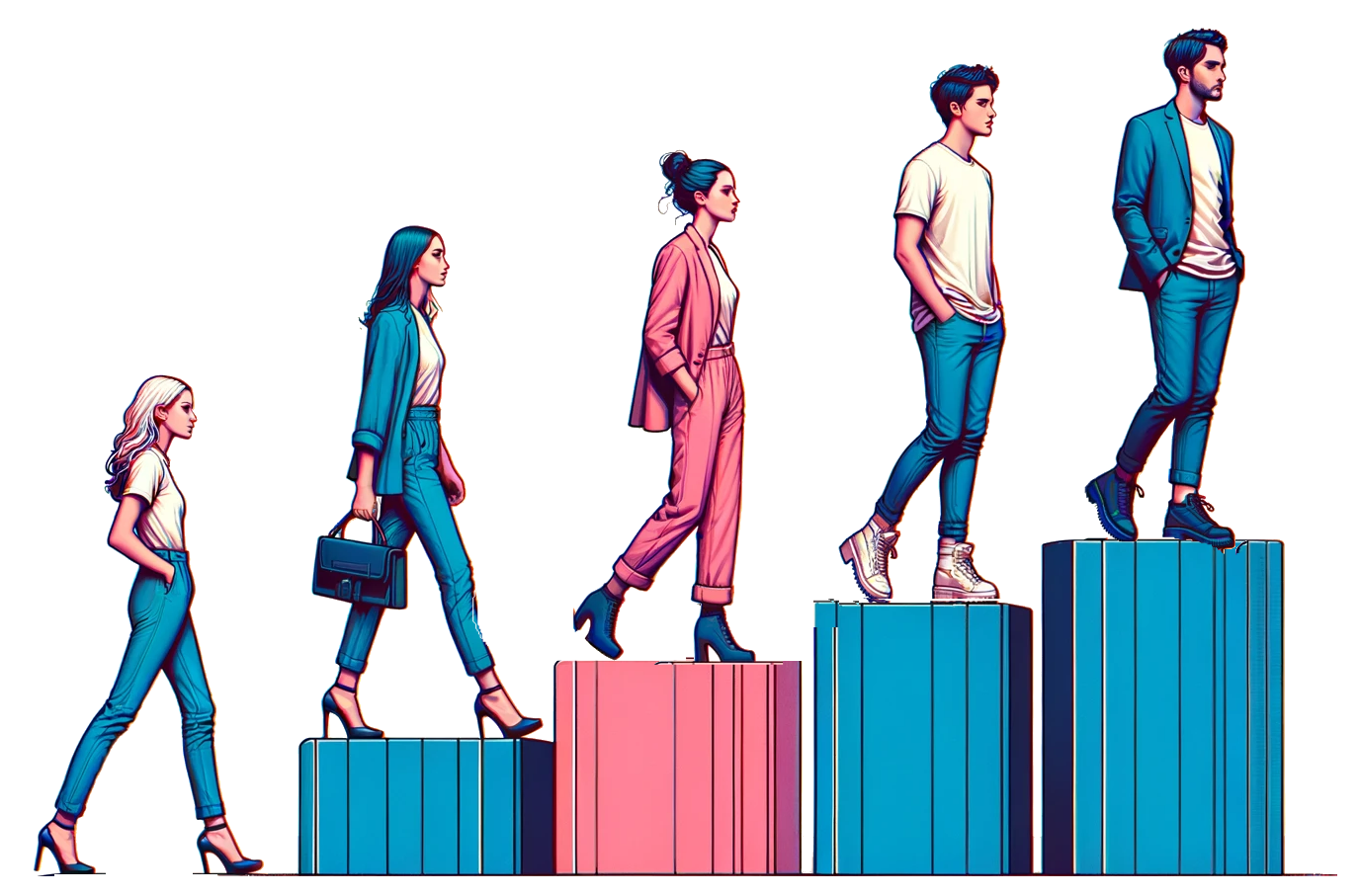Gender wage gap
How much lower is your salary because you are a woman?
How much lower is your salary because you are a woman?
In Latin America and the Caribbean, the value of a salary is determined not only by its monetary worth but also by the gender of the recipient. On average, for every $100 earned by a man, women earn $40 less. This statistic, more than just a number, reflects a disparity that transcends borders, impacting the economy and the independence of women throughout the region. Are you curious about the magnitude of this gap in your country and how it compares to neighboring countries? La Data Cuenta invites you to explore our interactive platform and read our report to understand the patriarchal complexities underlying these numbers.
In Latin America and the Caribbean, the value of a salary is determined not only by its monetary worth but also by the gender of the recipient. On average, for every $100 earned by a man, women earn $40 less. This statistic, more than just a number, reflects a disparity that transcends borders, impacting the economy and the independence of women throughout the region. Are you curious about the magnitude of this gap in your country and how it compares to neighboring countries? La Data Cuenta invites you to explore our interactive platform and read our report to understand the patriarchal complexities underlying these numbers.

Journalist, analyst, and data visualization: Hassel Fallas
Published: March 18, 2024
Journalist, analyst, and data visualization: Hassel Fallas
Published: March 18, 2024
"
When a woman earns less money at work, her autonomy is compromised. She may struggle to decide whether to stay in an abusive relationship, access healthcare services, or pursue education and professional training opportunities. The state’s failure to ensure these essential rights leaves them vulnerable in multiple respects
"
Liliana Castañeda Rentería, lawyer and PhD in Social Sciences from the University of Guadalajara in Jalisco, Mexico
Idania López, a Costa Rican who has worked as a graphic designer for a decade, faced gender pay inequality head-on. After being promoted to department head a year ago, she discovered her male predecessor earned $600 more per month. This difference, calculated annually, amounted to $7,800 less in income for her for the same workload. Her attempt to rectify this with the Human Resources Department was met with a conditional promise to match her salary only «if she demonstrated the same capacity» as her predecessor. A promise, ultimately, left unfulfilled.
López’s experience is not isolated. Across Latin America and the Caribbean, the gender pay gap is tangible, with women earning, on average, $40 less for every $100 that men earn. This income discrepancy varies significantly when examining each of the 28 countries in the region. For example, in Guatemala, the disparity is stark, with women earning just $39 for every $100 received by men. In contrast, Panama presents the smallest difference at $23.
This landscape is based on estimates from La Data Cuenta, utilizing data from the United Nations’ Global Human Development Index (HDI) 2021-2022 and annual per capita income averages by gender. To grasp the full magnitude of this inequality, one only needs to look at the second interactive graph accompanying this report. It visualizes salary discrepancies in absolute terms, where, on average, women in the region earn almost $7,000 less than men annually. Variations between countries can also be explored. The cases of Guyana, Chile, Trinidad and Tobago, and Mexico stand out, showing the widest absolute gaps.


Exploring the Causes
How did we get here? What factors contribute to such a pronounced disparity? Liliana Ibeth Castañeda Rentería, a lawyer and doctor in Social Sciences with a specialization in Social Anthropology from the University of Guadalajara in Jalisco, Mexico, offers expert insight into the causes behind these numbers.
According to Castañeda, in many societies, including Mexico, the prevailing view is that women work primarily as a secondary economic support for the family, rather than out of personal ambition or professional development. This notion is supported by historically assigned gender roles, where men are expected to assume the role of the main provider, relegating women to domestic spheres as homemakers and caregivers.
Although these perceptions are changing, they still dominate the mindset of many employers. Subject to these social and cultural prejudices, they undervalue the work performed by women, considering it less crucial and worthy of fair remuneration compared to men’s work.
Another critical aspect identified by the scholar is how motherhood is often seen as a hindrance to women’s dedication and loyalty to their companies. This perception can result in women being viewed as less indispensable or more easily replaceable in their job roles.
Finally, the doctor highlights the existence of a hidden wage gap. She explains that, although some institutions claim salary equity based on specific ranks or roles, in practice, women often have to work more than their male colleagues in equivalent positions without this being reflected in their pay. This situation underscores an inequality in the valuation of effort and the constant need for women to prove their worth and intellectual capability.
A study conducted by the Inter-American Development Bank (IDB) came to a similar conclusion, finding that the disparity in pay between men and women is rather attributed to unobservable characteristics associated with discriminatory gender biases. «These biases can be cognitive in nature or stem from inadequate laws, discrimination, or labor costs related to childcare that are not visible in society,» the document states.
"
The wage gap negatively affects not only women’s incomes but also their opportunities and rights. On one hand, many women earn less because they can dedicate less time to paid work, mainly due to their unpaid caregiving responsibilities. This deprives them of access to benefits like social security and housing, among other fundamental rights. On the other hand, women who work full-time also face wage discrimination, reflecting the widespread undervaluation of female labor.
"
Liliana Castañeda Rentería, lawyer and PhD in Social Sciences from the University of Guadalajara in Jalisco, Mexico
Education and the Gap
The battle for gender equity in the workplace faces complex and multifaceted obstacles, with education being one of them. Contrary to expectations that a higher level of education would act as an equalizer of income, data reveals a more tangled reality.
The analysis conducted by La Data Cuenta shows a weak correlation (1%) between the level of education achieved by women—specifically, completing secondary education—and the reduction of the gender wage gap.
This finding suggests that, while attaining higher levels of education is crucial for female empowerment and access to better job opportunities, it alone does not ensure income equity. Other factors have a more significant impact on this inequality, as previously mentioned.
"
«This does not mean education is not important. On the contrary, it’s widely proven that higher female education has a significant impact on their children’s and their social mobility. It’s a stronger influence on the family than that of men. Therefore, the increase of women in higher education levels is positive in all aspects.»
"
Liliana Castañeda Rentería, lawyer and PhD in Social Sciences from the University of Guadalajara in Jalisco, Mexico
Moreover, academic Castañeda points out that to better understand this phenomenon, a deeper look into the disciplines or educational areas chosen by women to develop their professional lives is necessary.
In her research, Castañeda has found that many women lean towards social sciences and humanities, fields that, although vital for society, are often associated with lower remunerations. Conversely, in STEM careers (Science, Technology, Engineering, and Mathematics), known for their competitive salaries, there’s a low female presence.
This phenomenon is not accidental nor merely a matter of personal preference between men and women. It’s deeply influenced by entrenched gender stereotypes and social expectations that outline and limit women’s professional choices from a young age.
"
Women face pressures about what roles are ‘appropriate’ for their gender and the consequences if they deviate from these expectations. For example, even if a woman has the training and capacity to excel in engineering, the pressure to comply with traditionally feminine roles (mother, wife, caregiver) or the perception of having to sacrifice other aspects of her personal life may lead her to occupy positions that do not reflect her level of competence or area of study, contributing to wage gaps.
"
Liliana Castañeda Rentería, lawyer and PhD in Social Sciences from the University of Guadalajara in Jalisco, Mexico
This horizontal segregation in career choice underscores how gender roles and stereotypes not only influence women’s educational and professional decisions but also play a crucial role in perpetuating the gender wage gap.

The world of employment and the weight of gender roles
Despite facing numerous obstacles, women have made strides in joining the workforce, albeit gradually. The labor force participation rate, a key indicator measuring the percentage of working-age people who are employed or actively seeking employment, shows that, in Latin America and the Caribbean, the proportion of women employed or seeking work increased from 43% to 50% between 1990 and 2021.
While still low, women’s gradual increase in workforce participation seems to narrow the wage differences. At least, that’s what the data analysis for this publication shows, indicating a negative relationship between the two variables (0.55). This means that, in the dataset, higher women’s employment participation would correlate with a smaller gender pay gap.
However, this data should be approached with caution. Castañeda warns that although women’s educational advancement—especially those completing university and postgraduate programs—leads to greater labor market insertion, many of them stop working upon marriage or even before becoming mothers.
This phenomenon has been extensively studied by Professor Claudia Goldin, the 2023 Nobel Prize in Economics, who proved that the income difference between men and women is not explained by biological reasons, nor by educational level or chosen career. Instead, Goldin has shown that most of the wage gap between men and women, with the same types of jobs, emerges after the birth of the couple’s first child.
"
This is because, when women are assigned the responsibility for child care, domestic chores, and elder care, they have less time to dedicate to their careers and, as a result, earn less. Why do women, and not men, step away from these better-paid opportunities? Because ‘demanding jobs’ are high-pressure and require prioritizing them over all other aspects of their lives. And women’s lives are weighed down by social norms and expectations of their roles at home. If women could have equity within their families, they would have a better chance of achieving equality at work as well.
"
Claudia Goldin, Nobel Prize in Economics 2023
The data, personal experiences, and academic evidence from experts leave little room for doubt that social structures and entrenched gender roles keep women at an economic disadvantage. Real change requires not only policies that promote gender equality in the workplace but also a cultural transformation that revalues women’s work and equitably distributes caregiving responsibilities within households.

Independent data-driven journalism since 2013
For inquiries about courses, consultations, or project development in data analysis and visualization, please email: hassel@ladatacuenta.com
